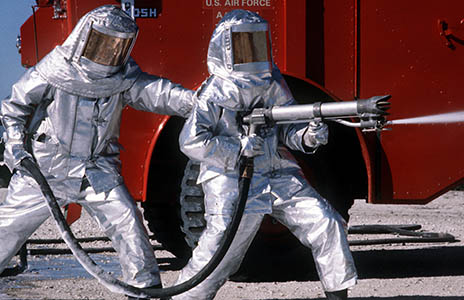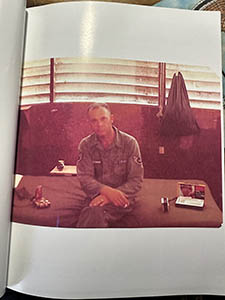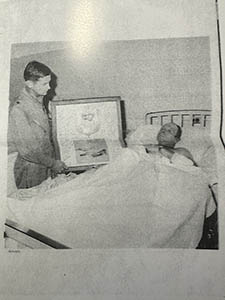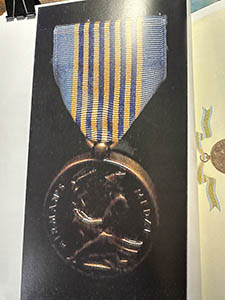Air Force Korean War Coal City, IL Flight date: 07/24/24
By Frank Hauenschild, Honor Flight Chicago Veteran Interview Volunteer
Donald W. McCollough, born near the small town of Jewett, Illinois, was the middle child of a family of eight. His parents, Harold and Ethel, worked on a farm that grew sugar cane. Seeking a change, Harold and Ethel relocated to Champaign, Illinois where Harold was first employed with the railroad and then at a local lumber yard.
With WWII beginning and the United States turning into a wartime economy, Harold, being over the age of service, loaded up his family and settled near Morris, Illinois. There, Harold took employment as a welder that was constructing Landing Ship, Tanks (LST) in Seneca, Illinois. With WWII ending and the need for LST’s ended, Harold worked temporarily at a local lumber yard and then continued with his welding career at the Caterpillar factory until his retirement.
Donald, first entering elementary school in Morris, related that he got plenty of miles in going back and forth to school. “It is somewhat true when people say in the old days that kids had to walk six miles to and from school, which I had to do, except ‘it wasn’t uphill both ways,’” Donald explained. Donald completed his first eight years of school in the same one-room schoolhouse where he first started classes.
Donald, admitting that he was a bit “wild and ambitious” during his youth, decided that continuing his education was not going to be his forte. “I figured that after completing eighth grade, I knew enough to seek my own career path.” While visiting his Uncle Gene in Greenfield (Greenville), Illinois, and doing small chores for him, Uncle Gene offered him a job where he was employed in the oil industry, “Working as a roughneck in the oil fields was tough work, but being 15/16 years old, I was young and energetic then. I did a lot of traveling as I worked in numerous oil fields in Southern Illinois and in Indiana.
After working as a “roughneck,” Donald returned to his family in Morris. Not desiring to return to school, Donald took work in a factory. “At that time, the Korean War was going on, so I was employed in a plant that manufactured shell casings for the M-5 rifles being used in the war.” While being employed at the factory, he met and became good friends with two other employees who were about the same age as Donald. “We always talked, I told them that I always considered military service as an option, and that if I enlisted, I would choose the Navy.” Being intrigued by the conversations, Donald and his two buddies, went to the recruitment office in Joliet, Illinois.
Donald described the recruitment office as being “old school:” all of the branches of the military were located in the same office space. Donald and his friends’ first stop was with the Navy recruiter. Ready to enlist with the Navy, the recruiter regrettably informed them that they were not accepting enlistments at that time. Still desirous of joining the military, Donald walked down the hall to other recruiters. Not especially as keen on being in the Army or Marines, he passed their offices and eyed-up the Air Force office. “It didn’t take me long to decide that I was going to enlist in the Air Force.” Donald explained. Being only seventeen at that time, Donald needed his parents to consent for his enlistment. “Though my mother was disappointed that I was not going to return to school, both my parents signed off on my enlistment with the Air Force.”
Upon being sworn in, Donald was sent to Sampson Air Force Base in New York for his basic training on October 28, 1953. Boot camp lasted just shy of three months for Donald and he was then sent to Hunter AFB in Savannah, Georgia. At Hunter, Donald began his Air Force career as a firefighter. His firefighting training was akin to on-the-job training. “I was assigned as a firefighter and placed on a duty crew. Though I was part of a crew that worked 24 hours on and 24 hours off, I, and others were always training.” Donald explained that his training consisted of structural firefighting and also aircraft firefighting, which included rescue operations on all types of aircraft. Donald, still being young and ambitious, also completed correspondence school classes and promotional classes during his down time.





It wasn’t all work while at Hunter AFB. There he met the love of his life, Mary Elizabeth Hooks, whom he married while stationed at Hunter. Being married and now with his first child, Wayne, the Air Force decided that they needed Donald at another Air Force Base. With only one stripe on his sleeve, “I didn’t have much authority to refuse the assignment or even ask to take my family when I was ordered to Wethersfield Air Base in England.” Boarding the USS George W. Gothel, he sailed to England and began his 18-month tour overseas. Being on another air base with different aircraft, he continued his on-the-job training on F-84s and F-86’s. “Those fighter jets were slow to take off, compared to later aircraft, as we kept watch on the flight line. They would use the whole runway and were often take-off assisted by ‘jet-assisted take-off’ (JATO) when the fighters were fully loaded with fuel and armaments.”
Completing his tour in England, Donald was assigned to Webb AFB in Texas in 1957. Choosing to re-enlist, and receiving a promotion to Airman 1st Class, Donald had his choice in selecting Air Force Bases and also taking his family with him. After discussions with his wife, Mary, they first considered Chanute AFB, in Illinois, as an option. Deciding against returning to Illinois, Donald selected to return to Hunter AFB in Savannah, where he first began his firefighting training.
While at Hunter, Donald and Mary had their second child, Mary. During Donald’s second tour at Hunter, the family decided to request a duty assignment overseas now that Donald was able to bring his family with him. Donald requested a transfer to Orly Air Force Base in Paris, France. Arriving in Paris, they found a farmhouse for rent about sixteen miles from Orly, which became their home for the next four years. While in France, they welcomed their next two children, Billy and Roger. “The kids had to go to school and the older ones were allowed in school at Orly. Roger, being too young to attend school at the air base, had to start school in a French school. Donald related that they knew his teacher at that school and that he could speak fluent English along with his native French. “He warned us, though, there would be no special treatment for Roger in being taught in English, his classes were in French and as such, Roger learned French at a very young age.”
Being reassigned back to the States after four years in France, Donald was assigned to McConnell AFB in Wichita, Kansas. There they welcomed the last of their children, David, to their family. Donald again re-enlisted and was sent back to France. The McCollough’s spent two years at Chateauroux AFB and then a year at Wiesbaden AFB in Germany. Donald, approaching completion of his last enlistment term, decided to re-enlist again. With this enlistment, and the Vietnam War continuing to escalate, he was informed that he would be sent to Vietnam, no avoiding this assignment. Securing his family in Yorkville, Illinois, during his 30-day leave, Donald was off to Vietnam.
Donald was assigned to Cam Rahn Bay Air Force Base. The base, due to its location, was fairly safe and was used for munitions storage and for a launching point for bombers and fighter aircraft. “It was a large base and was always busy. All types of aircraft would take-off and land at Cam Rahn,” Donald explained. His duty days were full, still continuing his 24 hour on/24 hour off schedule at the two crash stations near the flight line. “We continued to train, but instead of me being trained, I, being a Technical Sargeant, was training the younger recruits in the art of firefighting.”
Life was good at Cam Rahn Bay even though most everyone was restricted to the Air Base. Donald related that while his paycheck was sent to Mary and his family, he took a side job at the Non-Commissioned Officers Club at the base on his off-duty days. “That gave me a little spending money while in Vietnam, where I could indulge a bit at the Army base a few miles from the Air Base.”
In the early morning hours of January 28, 1969, Donald’s life would drastically change. “We were woken by the alarm at the crash station a little after 5 a.m. The Control Tower reported that there was a plane accident.” Donald, being the NCO in charge of the shift, donned his firefighting proximity suit and boarded the crash truck. Donald recalled that there were four crew members on the truck, a driver, a turret operator and then Donald and another firefighter as lineman who would conduct rescue operations and hand-line fire suppression as needed.
Leaving the station, they knew there was a severe plane accident. While enroute to the now stopped plane, they were informed that the fighter jet was fully armed with cluster bombs, heat seeking missiles and was fully loaded with fuel, both on-board and in external fuel tanks. Donald, while rushing to the crash site, could see parts of the plane, including bombs and missiles, along the runway that were torn from the plane during the attempted take-off. Donald later learned that when the fighter began its take-off, the left main landing gear malfunctioned which caused the plane to veer left off the runway. The plane then hit an arrestor cable pillar box which totally disabled the fighter from any recovery. “Once the pilot began rolling and engaged the afterburners, there was no stop button and the two-man crew’s fate was more or less sealed, at that point,” Donald explained.
Donald’s crash truck stopped near the fighter and in full-protective gear, Donald grabbed a hose handline and rushed to the plane to rescue the crew. Donald knew at that time, other crash trucks were trying to extinguish fuel fires on and off the runway and to keep weapons from exploding. Donald was able to jump on the wing of the downed aircraft and went directly to the cockpit. Upon reaching the cockpit, he immediately saw that the canopy was gone as well as the crew. “I couldn’t determine whether they tried to eject or that they were thrown from the plane. Either way, there wasn’t much hope in their survival, ejection seats, by their design, were meant to be used during flight, not while on the ground.”
Seeing that the crew were no longer in the plane, Donald knew there was no rescue to be made and it was time to leave the plane for his own safety. Leaving the charged hose line that he had when he jumped on the wing, he retreated from the plane. Seconds after jumping off the wing, still having his proximity suit on, with his head cover that limited his vision, he saw a “bright white light” that was approaching the plane. The “bright white light” was a heat-seeking missile that ignited and was seeking a heat-sourced target: the burning fighter that Donald was fleeing from.
The missile slammed into the fighter jet and exploded. Donald, with no time to flee any further, was struck by one of the guidance fins from the missile. The fin tore through Donald’s protective gear and severed his right arm. Due to the injury, Donald was semi-conscious lying on the ground. Being in excruciating pain, he did recall being attended to almost immediately before totally losing consciousness. The attendee was a doctor that arrived at the scene of the crash on an ambulance. Donald later learned that the doctor was able to control the bleeding before transporting Donald to the base hospital.
Donald underwent numerous surgeries and treatment sessions while at the Cam Rahn Bay base hospital. “I believe I was at the base hospital for at least 30 days or so, I was in and out of consciousness pretty much the whole time I was there due to the pain medications that I was being given.” Donald recalled. After sufficient recovery at the base hospital, Donald, along with a doctor at his side, was air-lifted to Glenview Naval Air Station where he was ground transported to Great Lake Naval Hospital. At Great Lakes, he was reunited with his wife, Mary, who was constantly informed of his condition while at Cam Rahn Bay.
Following his stay at Great Lakes Naval Hospital for a number of months, Donald was sent to Walter Reed Hospital where he completed further treatment and rehabilitation. After three months at Walter Reed, Donald returned to his wife and family in Morris, Illinois. Donald completed sixteen years of service with the Air Force and received “The Airman’s Medal for Heroism“
Donald, upon being discharged, went to the Veteran’s Service Office that was located on the top floor of the Grundy County Bank in Morris. After receiving information regarding VA benefits, the service officer asked Donald if he was looking for a job, which he acknowledged affirmatively. The office said that he would be a perfect fit for taking his place as he was being transferred to the Springfield Veteran’s Office. Being further interviewed, Donald was offered the position of Veterans Service Officer and remained there from 1970 to 1979 when he fully retired. “I was honored and very appreciative of the job offer, but honestly, I had to once again partake in “on-the-job” training. Thank goodness there was a secretary/assistant there to teach me the ropes in dealing with the VA.”
Donald’s story does not end there. Some forty-six years after Donald’s injury, the young doctor on the ambulance at the crash site, recalled the accident. Doctor Glenn Thoreson, retired from his medical practice in Mayville, North Dakota, was reading a book written by a Vietnam War pilot. Recalling the accident, Doctor Thoreson began researching the accident to find out what eventually happened to Donald, as his immediate treatment was the only time he encountered Donald. With luck and knowing a few historians, Doctor Thoreson located and reached out to Donald. Within a few days of an e-mail exchange, the two of them talked on the phone. After that, Donald and then Captain Glenn Thoreson, MD, reunited and now are close friends. Donald recalled that during their reunion, Doctor Glenn said that if he wasn’t there on the ambulance at the crash site, that Donald would have not survived due to the extent of injuries, and Donald said, “I know and I believe that.”
You can see the McCollough/Thoreson reunion on You Tube: https://www.youtube.com/watch?v=OYTWEjhfprI
Donald now enjoys his retirement in his home in Coal City, Illinois and continues to spend quality time with his children.


